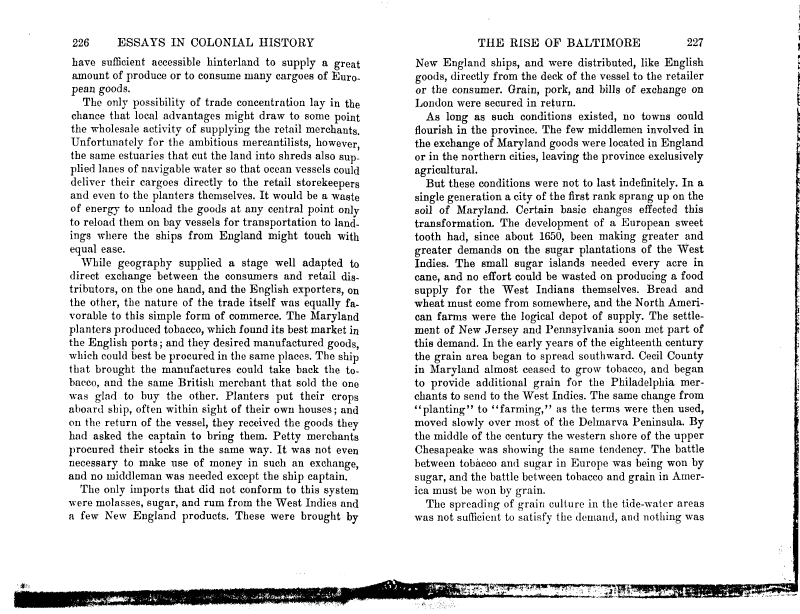|
226
ESSAYS IN COLONIAL HISTORY
THE RISE OF BALTIMORE
227
have sufficient accessible hinterland to supply a great
amount of produce or to consume many cargoes of Euro-
pean goods.
The only possibility of trade concentration lay in the
chance that local advantages might draw to some point
the "wholesale activity of supplying the retail merchants.
Unfortunately for the ambitious mercantilists, however,
the same estuaries that cut the land into shreds also sup-
plied lanes of navigable water so that ocean vessels could
deliver their cargoes directly to the retail storekeepers
and even to the planters themselves. It would be a waste
of energy to unload the goods at any central point only
to reload them on bay vessels for transportation to land-
ings where the ships from England might touch with
equal ease.
While geography supplied a stage well adapted to
direct exchange between the consumers and retail dis-
tributors, on the one hand, and the English exporters, on
the other, the nature of the trade itself was equally fa-
vorable to this simple form of commerce. The Maryland
planters produced tobacco, which found its best market in
the English ports; and they desired manufactured goods,
which could best be procured in the same places. The ship
that brought the manufactures could take back the to-
bacco, and the same British merchant that sold the one
was glad to buy the other. Planters put their crops
aboard ship, often within sight of their own houses; and
on the return of the vessel, they received the goods they
had asked the captain to bring them. Petty merchants
procured their stocks in the same way. It was not even
necessary to make use of money in such an exchange,
and no middleman was needed except the ship captain.
The only imports that did not conform to this system
were molasses, sugar, and rum from the "West Indies and
a few New England products. These were brought by
New England ships, and were distributed, like English
goods, directly from the deck of the vessel to the retailer
or the consumer. Grain, pork, and bills of exchange on
London were secured in return.
As long as such conditions existed, no towns could
nourish in the province. The few middlemen involved in
the exchange of Maryland goods were located in England
or in the northern cities, leaving the province exclusively
agricultural.
But these conditions were not to last indefinitely. In a
single generation a city of the first rank sprang up on the
soil of Maryland. Certain basic changes effected this
transformation. The development of a European sweet
tooth had, since about 1650, been making greater and
greater demands on the sugar plantations of the West
Indies. The small sugar islands needed every acre in
cane, and no effort could be wasted on producing a food
supply for the West Indians themselves. Bread and
wheat must come from somewhere, and the North Ameri-
can farms were the logical depot of supply. The settle-
ment of New Jersey and Pennsylvania soon met part of
this demand. In the early years of the eighteenth century
the grain area began to spread southward. Cecil County
in Maryland almost ceased to grow tobacco, and began
to provide additional grain for the Philadelphia mer-
chants to send to the West Indies. The same change from
"planting" to "farming," as the terms were then used,
moved slowly over most of the Delinarva Peninsula. By
the middle of the century the western shore of the upper
Chesapeake was showing the same tendency. The battle
between tobacco and sugar in Europe was being won by
sugar, and the battle between tobacco and grain in Amer-
ica must be won by grain.
The spreading of grain culture in the tide-water areas
was not sufficient to satisfy the demand, and nothing was
|

